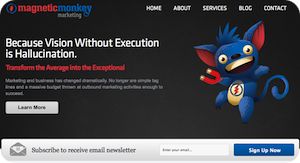 Why is it that most websites just suck? Yes, there are a few examples of great sites, but for the most part sites suffer from “word vomit”, a lack of compelling graphics, little-to-no organization and absolutely no sense of story, journey or directed purpose. You would think that everyone knows by now that your website is your primary face in cyberspace, so why take it for granted that everyone who visits your site will somehow psychically know what you intended to communicate?
Why is it that most websites just suck? Yes, there are a few examples of great sites, but for the most part sites suffer from “word vomit”, a lack of compelling graphics, little-to-no organization and absolutely no sense of story, journey or directed purpose. You would think that everyone knows by now that your website is your primary face in cyberspace, so why take it for granted that everyone who visits your site will somehow psychically know what you intended to communicate?
In recent years there has been a huge consumerization push into the business-to-business world and this has driven the need for great web presence. Great websites all have elements of:
- Education: It may sound trite, but the reason for your website is to educate your prospect on not just what you do, but how you do it, who should care, where it should be done, when it should be done and why they should care
- Motivation: If your site is constructed correctly it will motivate your prospect to continue to click through in order to uncover more valuable information. It should also be constantly refreshing to incent continuous return. So you should care about your site’s “stickiness” (measure of how often someone comes back and how long they stay).
- Conversion: The reason you created a website in the first place is to get your prospects to take some action: buy something, sign up for something, watch something, download something or even just change their opinion on something. If you aren’t tracking that and actively working towards that conversion they you are wasting everyone’s time.
Some observations for you to consider if you too would like to be considered a great web presence:
- Dynamic, fresh, story-driven content always wins
- Never underestimate your prospect’s desire to give you information
- Infrastructure and process is as important as content
- If you can’t be found, you don’t exist
- Build, measure, refine, repeat … daily
I’ll address these topics individually in future blogs so won’t take more of your time today. Wikipedia lists almost 50 types of websites, so the good news is that you aren’t restricted by structure or technology, only your imagination…that and the tenacity to constantly create new content, monitor page traffic, refine organization, refresh calls to action and new value exchange offerings.

Recent Comments